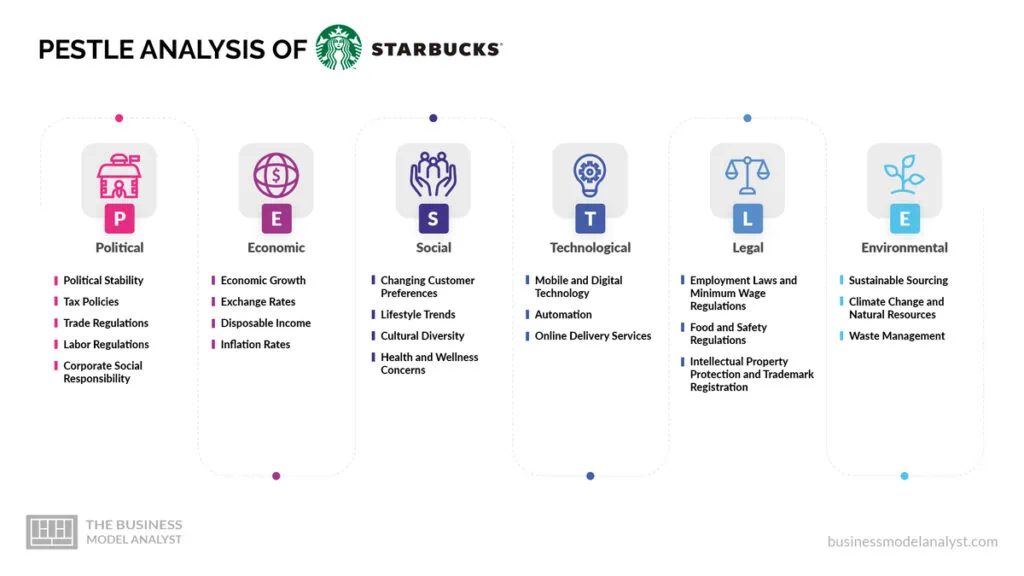Starbucks is a company that needs no introduction, so let’s take a deeper look at the Starbucks PESTLE Analysis to understand how it achieved such gargantuan success.
Contents
A Brief Overview of Starbucks
Starbucks is a global coffeehouse chain renowned for its premium coffee and inviting atmosphere. With over 31,000 outlets in 83 countries, it has become a staple in the lives of coffee enthusiasts worldwide. Established in 1971, Starbucks has evolved into an iconic brand, offering a diverse menu of high-quality beverages, snacks, and pastries.
The company employs more than 400,000 passionate individuals who are committed to delivering exceptional customer experiences. From cozy neighborhood stores to bustling city locations, Starbucks continues to provide a welcoming space for people to gather, savor delicious drinks, and enjoy moments of connection.
Various external factors contribute to the company’s success, as well as can act as a potential threat to its growth. Let’s take a look at the PESTLE analysis of Starbucks, considering the external factors that can impact the company and its continued success:
Starbucks Political Factors
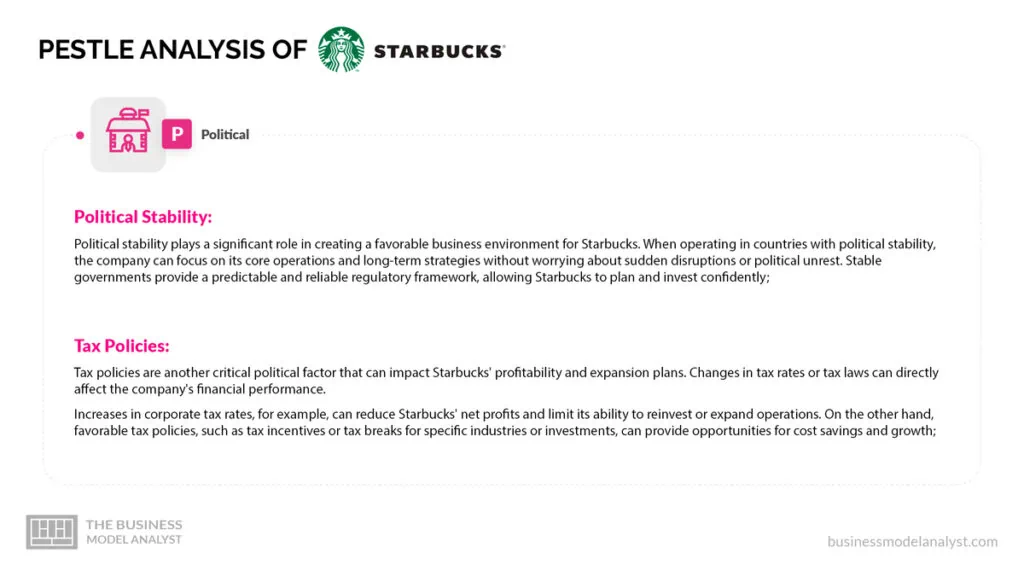
Political factors play a critical role in shaping the business environment in which Starbucks operates. Various political aspects, including stability, tax policies, trade regulations, labor regulations, and corporate social responsibility, influence the company’s operations.
- Political Stability: Political stability plays a significant role in creating a favorable business environment for Starbucks. When operating in countries with political stability, the company can focus on its core operations and long-term strategies without worrying about sudden disruptions or political unrest. Stable governments provide a predictable and reliable regulatory framework, allowing Starbucks to plan and invest confidently;
- Tax Policies: Tax policies are another critical political factor that can impact Starbucks’ profitability and expansion plans. Changes in tax rates or tax laws can directly affect the company’s financial performance.
Increases in corporate tax rates, for example, can reduce Starbucks’ net profits and limit its ability to reinvest or expand operations. On the other hand, favorable tax policies, such as tax incentives or tax breaks for specific industries or investments, can provide opportunities for cost savings and growth;
- Trade Regulations: As a global company, Starbucks relies on an extensive supply chain network, sourcing coffee beans and other ingredients from various countries. Trade agreements and tariffs can potentially impact the cost, availability, and reliability of these supplies.
Changes in trade regulations, such as the imposition of trade barriers or the renegotiation of trade agreements, can disrupt Starbucks’ supply chain and increase costs. On the other hand, the removal of trade restrictions can be beneficial to the company. Starbucks must monitor and adapt to changes in trade policies to mitigate potential risks and maintain the smooth flow of goods;
- Labor Regulations: Labor regulations and minimum wage policies are further political factors that can affect Starbucks’ labor costs and workforce management.
Governments often implement laws and regulations to protect workers’ rights and ensure fair employment practices. Compliance with these regulations is essential for Starbucks to avoid legal issues and maintain a positive corporate image.
Minimum wage policies, in particular, can directly impact labor costs, as the company operates numerous stores worldwide and employs a significant number of people. Changes in minimum wage rates can affect Starbucks’ cost structure and may require adjustments in pricing or operational strategies to manage expenses effectively;
- Corporate Social Responsibility: Furthermore, Starbucks often engages in corporate social responsibility initiatives and partnerships to foster positive relationships with governments and local communities. By actively participating in social and environmental causes, Starbucks demonstrates its commitment to being a responsible corporate citizen and can build goodwill and influence in the political sphere.
Political factors have a significant impact on Starbucks’ operations and business environment. By effectively monitoring and responding to political factors, Starbucks can navigate potential challenges, seize opportunities, and continue to grow as a global coffee retailer.
Starbucks Economic Factors

The following economic factors play a crucial role in shaping the company’s strategies and outcomes:
- Economic Growth: The overall economic conditions and trends in the countries where Starbucks operates can have a direct influence on its sales and profitability. During periods of robust economic growth, consumers generally have higher disposable incomes, leading to increased spending on non-essential items such as premium coffee and other Starbucks products.
Conversely, during economic downturns, consumers may reduce discretionary spending, affecting Starbucks’ sales and revenue. Starbucks needs to monitor economic indicators and adapt its strategies accordingly to leverage opportunities in growing economies and mitigate risks in slower-growing or recessionary markets;
- Exchange Rates: As a global company, Starbucks operates in various countries with different currencies. Fluctuations in currency exchange rates can impact the company’s revenue and profitability in international markets.
When the value of the domestic currency strengthens against other currencies, Starbucks’ international earnings may be negatively affected when converted back into the home currency.
On the other hand, a weaker domestic currency can boost Starbucks’ profitability in international markets by making its products more affordable for consumers. Managing foreign exchange risk is crucial for Starbucks to minimize the impact of currency fluctuations and maintain financial stability across its global operations;
- Disposable Income: The level of disposable income of consumers is a key factor that influences their willingness to spend on premium coffee and other Starbucks products. Higher disposable income allows consumers to allocate a more significant portion of their budget to discretionary purchases. Starbucks targets a segment of consumers who are willing to pay a premium for quality coffee and a unique experience.
Therefore, the availability of a sizable consumer base with sufficient disposable income is essential for Starbucks’ growth and profitability. Monitoring changes in income levels and consumer spending patterns helps Starbucks identify target markets and tailor its offerings to suit their preferences;
- Inflation Rates: High inflation can impact Starbucks’ input costs, pricing strategies, and profitability. Rising costs of raw materials, such as coffee beans, dairy products, and packaging materials, can squeeze profit margins if Starbucks cannot pass on these increased costs to consumers through price adjustments.
Moreover, inflation can erode consumers’ purchasing power, affecting their willingness to spend on premium-priced products like Starbucks. By carefully managing its supply chain, negotiating favorable contracts, and implementing pricing strategies, Starbucks can mitigate the impact of inflation on its profitability and even thrive.
In response to economic factors, Starbucks employs various strategies to adapt and thrive in different economic environments. For instance, during economic downturns, the company may focus on cost control, operational efficiency, and value-oriented promotions to maintain customer loyalty and affordability.
During periods of economic growth, Starbucks may prioritize expanding its store network, investing in new markets, and introducing innovative products and experiences to capitalize on consumer willingness to spend.
Understanding and effectively responding to economic factors are crucial for Starbucks’ financial performance and sustained growth. Continuous monitoring of economic indicators allows the company to identify opportunities, manage risks, and make informed decisions to stay competitive in the dynamic global market.
Starbucks Sociocultural Factors

As a global coffeehouse chain, Starbucks operates within a dynamic sociocultural environment that significantly influences its business operations and strategies. Several sociocultural factors are crucial in shaping the company’s approach to product offerings, marketing, and customer engagement.
- Changing Customer Preferences: Changing consumer preferences have a profound effect on Starbucks’ operations. With an increasing focus on healthier food and beverage options and sustainable products, consumers are demanding more choices that align with their health-conscious lifestyles.
Consequently, Starbucks has responded by expanding its menu to include a broader range of nutritious and plant-based options, such as almond milk and gluten-free snacks. This shift in consumer preferences necessitates continuous innovation and adaptation to ensure Starbucks remains relevant and appealing to its target market;
- Lifestyle Trends: Lifestyle trends also significantly influence Starbucks’ business strategy. As people lead busier lives, convenience becomes paramount. Consumers often seek quick and easy solutions to satisfy their coffee cravings.
Recognizing this, Starbucks has embraced takeaway and delivery services, enabling customers to enjoy their favorite beverages and food on the go. By leveraging mobile ordering apps and partnering with third-party delivery platforms, the company has successfully capitalized on the demand for convenience, enhancing customer satisfaction and driving growth;
- Cultural Diversity: Cultural diversity presents both opportunities and challenges for Starbucks. Operating in various countries with diverse cultures, the company must navigate and adapt to local preferences and cultural norms.
Starbucks has implemented localized strategies to cater to different tastes and preferences, such as introducing matcha-flavored beverages in Japan or offering Chai Tea Lattes in India. This cultural sensitivity has fostered customer loyalty and positioned Starbucks as a global brand that respects and embraces diversity;
- Health and Wellness Concerns: Health and wellness concerns have become increasingly prevalent among consumers, influencing their choices and shaping Starbucks’ menu options. As individuals become more health-conscious, they seek out products that align with their wellness goals.
In response, Starbucks has incorporated healthier alternatives, reduced sugar content, and expanded its tea and fruit-based beverage selection. Moreover, the company provides transparency by listing nutritional information on its menu boards, empowering consumers to make informed choices.
Starbucks operates in a sociocultural landscape that constantly evolves and impacts its business. The company remains adaptable to changing consumer preferences, recognizing the importance of healthier options and sustainable practices.
Starbucks Technological Factors
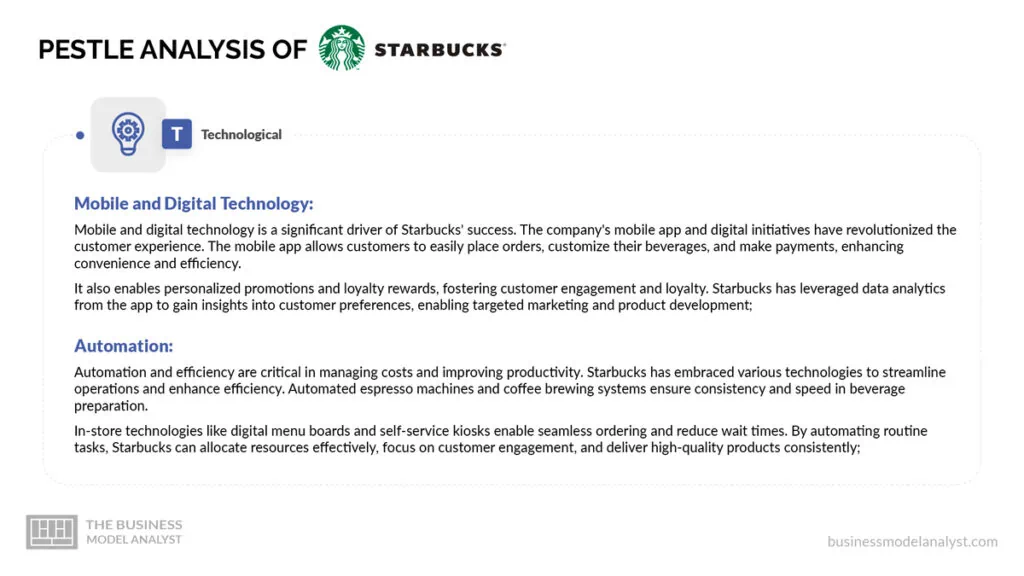
Technology plays a vital role in shaping Starbucks’ operations and customer experience. The company recognizes the importance of staying at the forefront of technological advancements to remain competitive and meet evolving customer expectations. Several key technological factors impact Starbucks’ business strategy and operations.
- Mobile and Digital Technology: Mobile and digital technology is a significant driver of Starbucks’ success. The company’s mobile app and digital initiatives have revolutionized the customer experience. The mobile app allows customers to easily place orders, customize their beverages, and make payments, enhancing convenience and efficiency.
It also enables personalized promotions and loyalty rewards, fostering customer engagement and loyalty. Starbucks has leveraged data analytics from the app to gain insights into customer preferences, enabling targeted marketing and product development;
- Automation: Automation and efficiency are critical in managing costs and improving productivity. Starbucks has embraced various technologies to streamline operations and enhance efficiency. Automated espresso machines and coffee brewing systems ensure consistency and speed in beverage preparation.
In-store technologies like digital menu boards and self-service kiosks enable seamless ordering and reduce wait times. By automating routine tasks, Starbucks can allocate resources effectively, focus on customer engagement, and deliver high-quality products consistently;
- Online Delivery Services: Online ordering and delivery platforms have become indispensable for meeting customer expectations in the digital age. Technological advancements in this area have transformed the way customers interact with Starbucks. The company has integrated online ordering capabilities into its app, allowing customers to conveniently place orders for pickup or delivery.
Collaborations with third-party delivery services have further expanded Starbucks’ reach and accessibility. These technological advancements not only improve customer convenience but also drive sales growth by tapping into the expanding market of online consumers.
Technological factors significantly influence Starbucks’ operations and customer experience. By embracing and leveraging these technological advancements, Starbucks stays at the forefront of innovation in the coffeehouse industry, ensuring continued success in a rapidly evolving technological landscape.
Starbucks Legal Factors
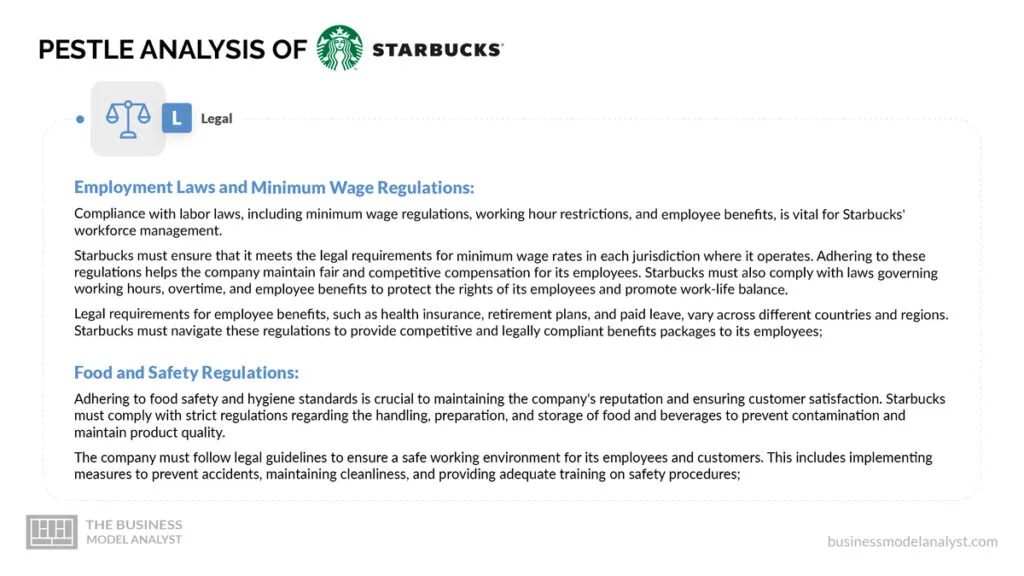
Legal factors play a crucial role in shaping Starbucks’ operations and ensuring compliance with regulations and laws. The company operates within a complex legal environment encompassing various aspects, including employment laws, food and safety regulations, and intellectual property protection.
Adhering to these legal factors is essential for Starbucks to maintain a positive reputation, protect its employees’ rights, ensure food safety, and safeguard its brand identity.
- Employment Laws and Minimum Wage Regulations: Compliance with labor laws, including minimum wage regulations, working hour restrictions, and employee benefits, is vital for Starbucks’ workforce management.
Starbucks must ensure that it meets the legal requirements for minimum wage rates in each jurisdiction where it operates. Adhering to these regulations helps the company maintain fair and competitive compensation for its employees. Starbucks must also comply with laws governing working hours, overtime, and employee benefits to protect the rights of its employees and promote work-life balance.
Legal requirements for employee benefits, such as health insurance, retirement plans, and paid leave, vary across different countries and regions. Starbucks must navigate these regulations to provide competitive and legally compliant benefits packages to its employees;
- Food and Safety Regulations: Adhering to food safety and hygiene standards is crucial to maintaining the company’s reputation and ensuring customer satisfaction. Starbucks must comply with strict regulations regarding the handling, preparation, and storage of food and beverages to prevent contamination and maintain product quality.
The company must follow legal guidelines to ensure a safe working environment for its employees and customers. This includes implementing measures to prevent accidents, maintaining cleanliness, and providing adequate training on safety procedures;
- Intellectual Property Protection and Trademark Registration: Protecting Starbucks’ brand, trademarks, and proprietary recipes is essential to prevent unauthorized use and maintain a competitive advantage. Starbucks must actively protect its trademarks and brand identity by registering them with relevant intellectual property authorities. This helps prevent others from using similar names or logos that could cause confusion among consumers.
Starbucks’ proprietary recipes and formulas are valuable assets. The company must take legal measures to safeguard these trade secrets and prevent unauthorized disclosure or use by competitors.
By navigating these legal factors effectively, Starbucks can mitigate legal risks, maintain compliance, and uphold its reputation as a responsible and innovative coffeehouse chain.
Starbucks Environmental Factors
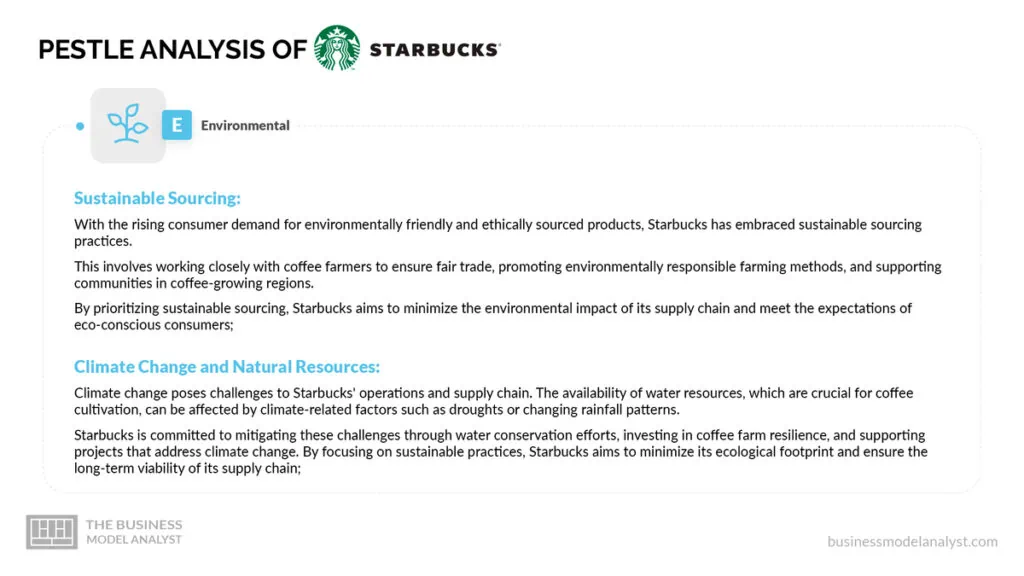
Environmental factors have become increasingly significant in shaping Starbucks’ business practices and corporate responsibility. As a global company, Starbucks recognizes the importance of addressing environmental concerns and implementing sustainable initiatives. The following factors are particularly relevant to the company:
- Sustainable Sourcing: With the rising consumer demand for environmentally friendly and ethically sourced products, Starbucks has embraced sustainable sourcing practices.
This involves working closely with coffee farmers to ensure fair trade, promoting environmentally responsible farming methods, and supporting communities in coffee-growing regions.
By prioritizing sustainable sourcing, Starbucks aims to minimize the environmental impact of its supply chain and meet the expectations of eco-conscious consumers;
- Climate Change and Natural Resources: Climate change poses challenges to Starbucks’ operations and supply chain. The availability of water resources, which are crucial for coffee cultivation, can be affected by climate-related factors such as droughts or changing rainfall patterns.
Starbucks is committed to mitigating these challenges through water conservation efforts, investing in coffee farm resilience, and supporting projects that address climate change. By focusing on sustainable practices, Starbucks aims to minimize its ecological footprint and ensure the long-term viability of its supply chain;
- Waste Management: Starbucks recognizes the importance of effective waste management in reducing its environmental impact. The company has implemented initiatives to minimize waste generation, promote recycling, and reduce packaging waste.
Starbucks encourages the use of reusable cups and offers incentives to customers who bring their own containers. Additionally, the company has set goals to increase recycling rates and explore innovative solutions for waste reduction. By prioritizing waste management practices, Starbucks aims to contribute to a more sustainable future.
Environmental factors play a vital role in shaping Starbucks’ sustainability efforts and corporate responsibility. Sustainable sourcing practices, addressing climate change impacts, and effective waste management are critical areas of focus for the company.
By proactively addressing these environmental factors, Starbucks aims to minimize its ecological footprint, meet consumer expectations, and contribute to a greener and more sustainable world.
Conclusion
To sum up, the PESTLE analysis of Starbucks reveals the external factors influencing its operations. By leveraging its strengths, such as a strong brand image and global presence, and effectively managing challenges like changing consumer preferences and economic fluctuations, Starbucks can continue to thrive in the ever-evolving coffee industry.


